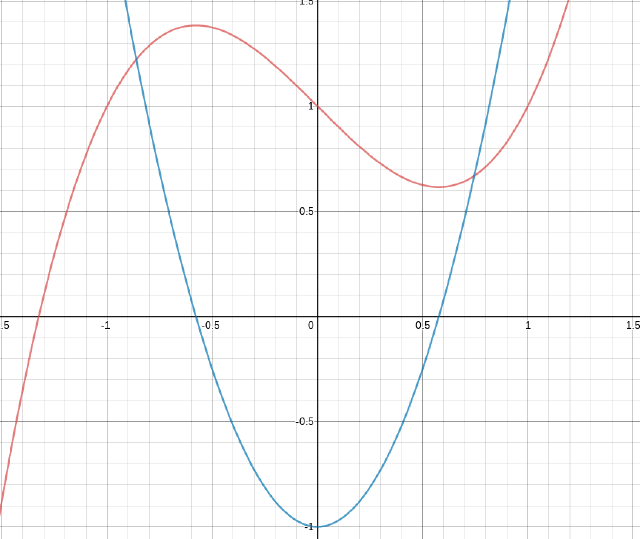Section 2.2, the derative
The derivative as a function
In the previous section, we found the derivative at a point which is a number.
We will consider the function $f’(x)$ given by: $$ f’(x) = \lim_{h\to 0} \frac{f(x+h) -f(x)}{h} $$ which gives the slope of the tangent line to the function $y=f(x)$ at any point $(x, f(x))$, whenever that limit exists.
Example:
Let $f(x) = x^3 - x + 1$
- Find the derivative $f’(x)$ of the function.
- Graph both $f$ and $f’$ on the same coordinate axes.
Here’s the graph
Example
Find the derivative of $f(x) = \sqrt{x-1}$ State the domain of $f’$.
Example
Find the derivative of $\displaystyle f(x) = \frac{2+x}{1-x}$
Other Notations
We’ll see many different notations both in this class and outside.
When a function is defined $y=f(x)$, we might write any of the following, which all mean the same thing:
- $f’(x)$
- $y’$ <— this notation we refer to as Newton’s notation1.
- $\displaystyle \dfrac{dy}{dx}$ <— these are referred to as Leibniz notation2
- $\displaystyle \dfrac{df}{dx}$
- $\displaystyle \dfrac{d}{dx} f(x)$
- $\displaystyle D_x f(x)$ <— you’ll see this in Calc 3 and differential equations
- $\dot{y}$ <— this is actually Newton’s notation from Principia. Physicists often use this in homage to Newton.
If we want to evaluate the derivative of $y=f(x)$ at $x=a$, we can write:
- $f’(a)$
- $\displaystyle \frac{dy}{dx} \Large|_{x=a}$ <— a vertical bar saying “derivative at this number”
- $y’(a)$
As I said above, they all mean the same thing. If you’re ever unsure of notation, please ask!
Differentiability
Definition
A function $f$ is differentiable at $a$ if $f’(a)$ exists. It is differentiable on an open interval (a,b) [or $(a, \infty), (-\infty, b), \text{ or } (-\infty, \infty)$] if it is differentible at every number in the interval.
Example
Polynomials, sine and cosine are nice and differentiable on $(\infty, \infty)$. Their derivatives, for reasons we’ll see later, are still polynomials, -cosine, and sine, respectively, whose domains are all real numbers.
Are there functions that aren’t differentiable?
Example
Where is the function $f(x) = |x|$ differentiable?
When is a function not differentiable?
Discontinuities
Cusps
Vertical tangents.
VIDEO HERE
Higher Derivatives
The second derivative is the derivative of the derivative of a function. For example, if $y=f(x)$, we’ll write:
- The first derivative if $f’(x)$ or $\dfrac{dy}{dx}$.
- The second derivative is $f’’(x)$ or $\dfrac{d^2y}{dx^2}$.
Example:
Let $f(x) = x^3 - x + 1$, find $f’’(x)$
NOTE: we did $f’$ above
Even higher derivatives:
Yes, we’ll go higher. We’ll see 3rd and 4th derivatives (and more in calc 2).
- $f’’’(x)$ is the third derivative <— last of the tick marks
- $f^{(4)}(x)$ is the fourth derivative
- $f^{(5)}(x)$ is the fifth derivative
- … and so on; the parentheses around the number mean derivative not exponent.
Physical interpretation of derivatives?
Velocity is derivative of position with respect to time. …. Acceleration is derivative of velocity with respect to time.
Posting that video might make me seem like a jerk. But that’s $f’’’(x)$3.
Now practice!
Head over to WebAssign and work on section 2.2. If you have questions, post them here, and either I or a fellow student will answer them quickly!
This isn’t what Newton wrote, though… ↩︎
Both Isaac Newton and Gottfried Leibniz invented calculus at the same time and separately. Long, and very interesting story. I teach a history of math class, by the way :slight_smile: ↩︎
Dad and math joke! :laughing: Jerk is the third derivative https://en.wikipedia.org/wiki/Jerk_%28physics%29 ↩︎
